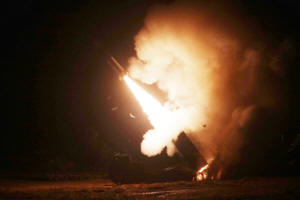South Korea, U.S. fire missiles into the sea to protest 'reckless' North
Korea test
 Send a link to a friend
Send a link to a friend
 [October 05, 2022]
By Joori Roh and Josh Smith [October 05, 2022]
By Joori Roh and Josh Smith
SEOUL (Reuters) -South Korea and the U.S.
military conducted rare missile drills and an American supercarrier
repositioned east of North Korea after Pyongyang flew a missile over
Japan, one of the allies' sharpest responses since 2017 to a North
Korean weapon test.
Nuclear-armed North Korea test-fired an intermediate-range ballistic
missile (IRBM) farther than ever before on Tuesday, sending it soaring
over Japan for the first time in five years and prompting a warning for
residents there to take cover.
The White House National Security Council called North Korea's latest
test "dangerous and reckless" and the U.S. military and its allies have
stepped up displays of force.
South Korean and American troops fired a volley of missiles into the sea
in response, South Korea's Joint Chiefs of Staff said on Wednesday, and
the allies earlier staged a bombing drill with fighter jets in the
Yellow Sea.
The USS Ronald Reagan, an American aircraft carrier that made its first
stop in South Korea last month for the first time in years, will also
return to the sea between Korea and Japan with its strike group of other
warships. The South Korean military called it a "highly unusual" move
designed to show the allies' resolve to respond to any threats from
North Korea.

U.S. Indo-Pacfic Command did not immediately respond to a request for
comment.
The South Korean military separately confirmed that one of its
Hyunmoo-2C missiles failed shortly after launch and crashed during the
drill, but that no one was hurt.
Footage shared on social media by a nearby resident and verified by
Reuters showed smoke and flames rising from the military base.
The fire was caused by burning rocket propellant, and although the
missile carried a warhead, it did not explode, South Korea's military
said.
It apologised for causing residents to worry.
It's not rare for military hardware to fail, and North Korea has
suffered several failed missile launches this year as well.
The Hyunmoo-2C is one of the South's latest missiles, however, and
analysts say its capability as a precision "bunker buster" make it a key
part of Seoul's plans for striking the North in the event of a conflict.
The fiery failure threatened to overshadow Seoul's efforts to
demonstrate military prowess in the face of North Korea's increasing
capabilities.
[to top of second column]
|

A surface-to-surface missile is fired
into the sea off the east coast in this handout picture provided by
the Defense Ministry, South Korea, October 5, 2022. South Korean
Defense Ministry/Handout via REUTERS

In its initial announcement of the drill, the South Korean military
made no mention of the Hyunmoo-2C launch or its failure, but later
media briefings were dominated by questions about the incident.
President Yoon Suk-yeol, who has made such displays of military
force a cornerstone of his strategy for countering the North, had
vowed that the overflight of Japan would bring a decisive response
from his country, its allies and the international community.
SECURITY COUNCIL MEETING
The U.N. Security Council will meet on Wednesday to discuss North
Korea at the request of the United States, despite China and Russia
telling council counterparts they were opposed to an open meeting of
15-member body. They argued that the council's reaction should be
conducive to easing the situation on the Korean Peninsula, diplomats
said.
U.S. President Joe Biden and Japanese Prime Minister Fumio Kishida
condemned North Korea's test in the "strongest terms," the European
Union called it a "reckless and deliberately provocative action",
and U.N. Secretary-General Antonio Guterres condemned the launch and
said it was a violation of Security Council resolutions.
It was the first North Korean missile to follow a trajectory over
Japan since 2017, and its estimated 4,600 km (2,850 mile) flight was
the longest for a North Korean test, which are usually "lofted" into
space to avoid flying over neighbouring countries.
Analysts and security officials said it may have been a variant of
the Hwasong-12 IRBM, which North Korea unveiled in 2017 as part of
what it said was a plan to strike U.S. military bases in Guam.
Neither North Korea's government nor its state media have reported
on the launch or disclosed what type of missile was used.
The flight has increased concerns that North Korea may soon conduct
an expected nuclear test, which would be the first since 2017.
South Korean officials said North Korea had completed preparations
for a test and might use a smaller weapon meant for operational use,
or a big device with a higher yield than in previous tests.

The launch was a "reckless and deliberately provocative action" that
violated U.N. security council resolutions, a European Union
spokesperson said.
(Reporting by Joori RohEditing by Chris Reese, Sandra Maler and
Gerry Doyle)
[© 2022 Thomson Reuters. All rights
reserved.]
This material may not be published,
broadcast, rewritten or redistributed.
Thompson Reuters is solely responsible for this content. |